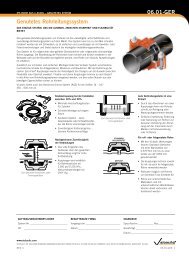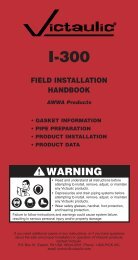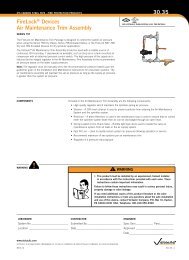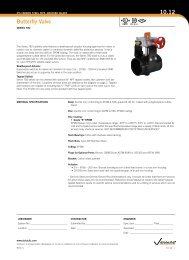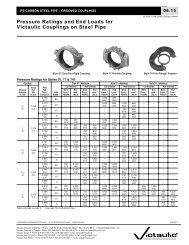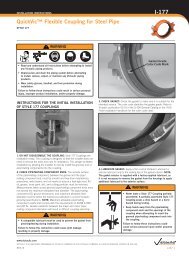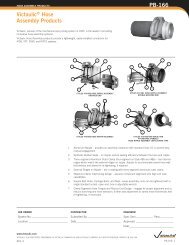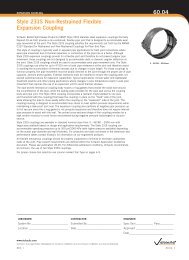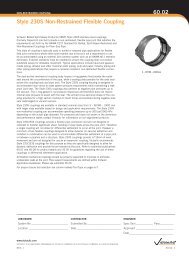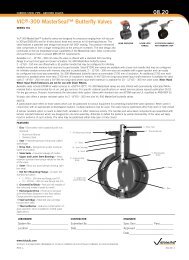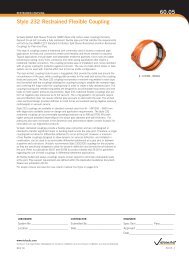Calculating and Accommodating Pipe Line Thermal Growth - Victaulic
Calculating and Accommodating Pipe Line Thermal Growth - Victaulic
Calculating and Accommodating Pipe Line Thermal Growth - Victaulic
- No tags were found...
You also want an ePaper? Increase the reach of your titles
YUMPU automatically turns print PDFs into web optimized ePapers that Google loves.
26.02ACCOMMODATING PIPE THERMAL GROWTH<strong>Victaulic</strong> offers the designer basic methods for accommodatingpipe movement due to contraction <strong>and</strong>/or expansion.1. <strong>Victaulic</strong> Style 150 Mover ® Expansion Joint2. Free-Floating System3. <strong>Victaulic</strong> flexible grooved couplings utilizing their linearmovement <strong>and</strong> deflection capabilities.4. Expansion loops utilizing <strong>Victaulic</strong> flexible couplings <strong>and</strong>fittings.These devices offer economical <strong>and</strong> attractive solutions toproblems of thermal movements. The following sections provideproduct information <strong>and</strong> suggestions which show the mechanicaladvantages of the grooved piping method. Since it is impossibleto predict all system designs, it should be noted that thesesuggestions are not considered as recommendations for aspecific system.1. <strong>Victaulic</strong> Style 150 Mover ® Expansion JointThe <strong>Victaulic</strong> Style 150 Mover Expansion Joint is a slip-typeexpansion joint which can provide up to 3" (76 mm) axialmovement, accommodating pipe expansion <strong>and</strong>/or contraction.(See 09.04)As with all types of expansion joints, the designer should guardagainst damaging conditions for which these devices cannotaccommodate, such as temperatures or pressures outside theproduct recommended range or motions which exceed theproduct’s capability.For proper operation of the expansion joint, the piping systemshould be divided into separate expansion/contraction sectionswith suitable supports, guides <strong>and</strong> anchors to direct axial pipemovement.Anchors can be classified as main or intermediate for thepurpose of force analysis. Main anchors are installed at terminalpoints, major branch connections, or changes of pipingdirection. The forces acting on a main anchor will be due topressure thrust, velocity flow <strong>and</strong> friction of alignment guides<strong>and</strong> weight support devices.Intermediate anchors are installed in long runs to divide theminto smaller exp<strong>and</strong>ing sections to facilitate using less complexexpansion joints. The force acting on the intermediate anchor isdue to friction at guides, weight of supports or hangers, <strong>and</strong> theactivation force required to compress or exp<strong>and</strong> an expansionjoint.<strong>Pipe</strong> alignment guides are essential to ensure axial movementof the expansion joint. Whenever possible, the expansion jointshould be located adjacent to an anchor within four (4) pipediameters. The first <strong>and</strong> second alignment guides on theopposite side of the expansion joint should be located amaximum distance of four (4) <strong>and</strong> fourteen (14) pipe diameters,respectively. Additional intermediate guides may be requiredthroughout the system for pipe alignment. If the expansion jointcannot be located adjacent to an anchor, install guides on bothsides of the unit, as mentioned.THE DATA PROVIDED IS INTENDED FOR USE AS ANAID TO QUALIFIED DESIGNERS WHEN PRODUCTSARE INSTALLED IN ACCORDANCE WITH THELATEST AVAILABLE VICTAULIC PRODUCT DATA.TABLE 2RECOMMENDED PIPE ALIGNMENT GUIDE SPACING<strong>Pipe</strong> SizeMaximumApproximateNominalDiameterInches/mmActualOutsideDiameterInches/mmDistanceto 1st Guideor AnchorInches/mmDistanceBetween1st to 2nd GuideInches/mm1 1.315 4" 1' - 4"25 33,7 101,6 406,41 1 / 4 1.660 5" 1' - 5"32 42,4 127,0 431,81 1 / 2 1.900 6" 1' - 9"40 48,3 152,4 533,42 2.375 8" 2' - 4"50 60,3 203,2 711,22 1 / 2 2.875 10" 2' - 11"65 73,0 254,0 889,03 3.500 1' - 0" 3' - 6"80 88,9 304,8 1066,83 1 / 2 4.000 1' - 2" 4' - 1"90 101,6 355,6 1244,64 4.500 1' - 4" 4' - 8"100 114,3 406,4 1422,45 5.563 1' - 8" 5' - 8"125 141,3 508,0 1727,26 6.625 2' - 0" 7' - 0"150 168,3 609,6 2133,68 8.625 2' - 8" 9' - 4"200 219,1 812,8 2844,810 10.750 3' - 4" 11' - 8"250 273,0 1016,0 3556,012 12.750 4' - 0" 14' - 0"300 323,9 1219,2 4267,214 14.000 4' - 8" 16' - 4"350 355,6 1422,4 4978,416 16.000 5' - 4" 18' - 8"400 406,4 1625,6 5689,618 18.000 6' - 0" 21' - 0"450 457,0 1828,8 6400,820 20.000 6' - 8" 23' - 4"500 508,0 2032,0 7112,024 24.000 8' - 0" 28' - 0"600 610,0 2438,4 8534,4IntermediateGuide2ndGuide14D1st"The Mover"1stGuideGuide4D2ndGuideSupportIntermediateGuide2 <strong>Calculating</strong> <strong>and</strong> <strong>Accommodating</strong> <strong>Pipe</strong> <strong>Line</strong> <strong>Thermal</strong> <strong>Growth</strong>



